
Triggerfish are about 40 species of often brightly colored fish of the family Balistidae. Often marked by lines and spots, they inhabit tropical and subtropical oceans throughout the world, with the greatest species richness in the Indo-Pacific. Most are found in relatively shallow, coastal habitats, especially at coral reefs, but a few, such as the oceanic triggerfish, are pelagic. While several species from this family are popular in the marine aquarium trade, they are often notoriously ill-tempered.

The lagoon triggerfish, also known as the blackbar triggerfish, the Picasso triggerfish, or the Picassofish, is a triggerfish, up to 30 cm in length, found on reefs in the Indo-Pacific region.
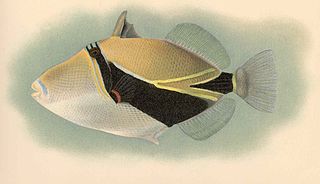
The reef triggerfish, also known as the rectangular triggerfish, wedgetail triggerfish or by its Hawaiian name humuhumunukunukuāpuaʻa, is one of several species of triggerfish. It is found at reefs in the Indo-Pacific and is the state fish of Hawaii.

The titan triggerfish, giant triggerfish or moustache triggerfish is a large species of triggerfish found in lagoons and at reefs to depths of 50 m (160 ft) in most of the Indo-Pacific, though it is absent from Hawaii. With a length of up to 75 centimetres (30 in), it is the largest species of triggerfish in its range.

The dottybacks are a family, Pseudochromidae, of fishes which were formerly classified in the order Perciformes, but this has been revised and the family is regarded as of uncertain affinities, or incertae sedis within the Ovalentaria, a clade within the Percomorpha. Around 152 species belong to this family.

The orange-lined triggerfish is a demersal triggerfish. Although Balistapus is a monotypic genus, it is closely related to the genus Balistoides.

The halfmoon triggerfish, Sufflamen chrysopterum, is a triggerfish of the tropical Indo-West Pacific area.
Although most species in the Red Sea pose no threat to humans, there are a few notable exceptions.
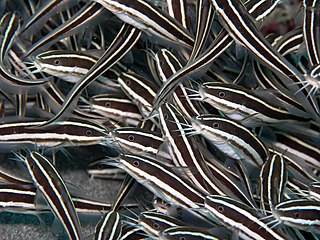
Plotosus is a genus of eeltail catfishes native to the Indian Ocean, the western Pacific Ocean and New Guinea.

Balistes vetula, the queen triggerfish or old wife, is a reef dwelling triggerfish found in the Atlantic Ocean. It is occasionally caught as a gamefish, and sometimes kept in very large marine aquaria.

The blackbelly triggerfish is a ray-finned fish in the family Balistidae found in the Indo-Pacific. It occasionally makes its way into the aquarium trade. It is sometimes known as the blackpatch triggerfish.
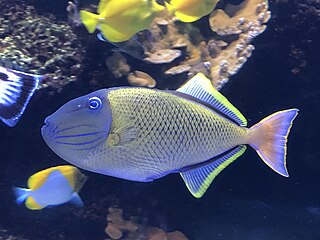
Xanthichthys mento, the redtail triggerfish, blue-throat triggerfish, or crosshatch triggerfish, is a species of triggerfish from the Pacific. It inhabits outer-reef areas at depths of 6–131 m (20–430 ft), and feeds on zooplankton. Xanthichthys mento grows to a size of 29 cm (11 in) in length and occasionally makes its way into the aquarium trade.

Xanthichthys ringens, the Sargassum triggerfish, is a species of triggerfish from the Western Atlantic, ranging from North Carolina (USA) to Brazil.
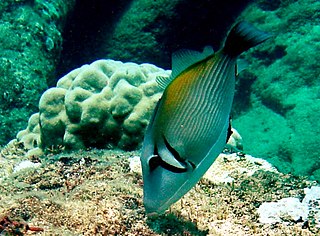
Sufflamen bursa, sometimes known as Lei Triggerfish, bursa triggerfish, scythe triggerfish or boomerang triggerfish, is a triggerfish from the Indo-Pacific. Its name is derived from the two markings behind its eyes that wrap around the fish similar to a Hawaiian Lei. The color of these markings changes depending on the fish's mood, in which case the colors may alter from yellow, dark brown, and black. It is a species of reef fish found in reef ecosystems in the Indo-Pacific, including Japan, Australia, and Hawaii. It occasionally makes its way into the aquarium trade.
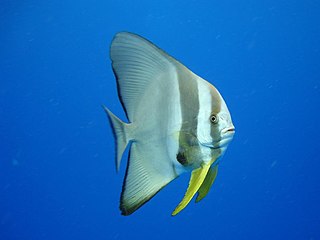
Platax is a genus of Indo-Pacific, reef-associated fish belonging to the family Ephippidae. There are currently five known extant species generally accepted to belong to the genus. They are one of the fish taxa commonly known as "batfish".

Fish are very diverse animals and can be categorised in many ways. Although most fish species have probably been discovered and described, about 250 new ones are still discovered every year. According to FishBase about 34,800 species of fish had been described as of February 2022, which is more than the combined total of all other vertebrate species: mammals, amphibians, reptiles and birds.

Coral reef fish are fish which live amongst or in close relation to coral reefs. Coral reefs form complex ecosystems with tremendous biodiversity. Among the myriad inhabitants, the fish stand out as colourful and interesting to watch. Hundreds of species can exist in a small area of a healthy reef, many of them hidden or well camouflaged. Reef fish have developed many ingenious specialisations adapted to survival on the reefs.

The stone triggerfish is the largest species of triggerfish.

The masked triggerfish is a species of triggerfish usually found living in coastal reefs or in lagoons. The range of depths where these triggerfish can live varies from 8 to 186 m.



















